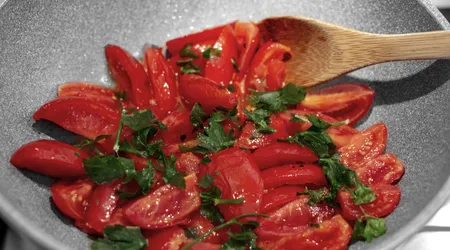San Marzano Tomatoes: Why They're So Popular in Italian Cuisine

San Marzano tomatoes, the red jewels of the Agro Sarnese-Nocerino region, embody the soul of Italian cuisine. Their fame transcends borders, captivating chefs and enthusiasts alike.
Announcements
What makes this tomato so special? The answer lies in a unique combination of terroir, tradition, and versatility.
Grown at the foot of Vesuvius, the San Marzano tomatoes They offer an unmistakable sweet and sour taste, protected by the DOP since 1996.
This article explores the reasons for their success, taking a close look at their history, quality, and their role on Italian and international tables.
Get ready to discover a product that is much more than just an ingredient: it is a symbol of excellence.
Announcements
A Unique Territory: The Secret of Flavor
Imagine fertile soil, nourished by volcanic ash, caressed by the Campanian sun. Here, in the Agro Sarnese-Nocerino, the San Marzano tomatoes.
The volcanic soil lends a distinctive minerality, while the Mediterranean climate enhances the sweetness. Each tomato is handpicked, ensuring superior quality.
The Protected Designation of Origin (PDO) protects this uniqueness, prohibiting imitations. No other place in the world replicates these conditions.
Harvest takes place between July and September, when the fruit reaches perfect ripeness. This artisanal process preserves the integrity of the flavor.
THE San Marzano tomatoes They're not just a product, but an expression of their territory. Their firm, slightly watery flesh makes them ideal for slow cooking.
++ Italian extra virgin olive oil: how to choose the right one for every recipe
An example? A Neapolitan ragù that cooks for hours, transforming the acidity into velvety sweetness.
It's not just the soil that makes the difference, but also the farmers' dedication. Small family farms keep tradition alive, passing down centuries-old techniques.
In 2025, the Danicoop cooperative introduced musical horticultural therapy, cultivating the San Marzano tomatoes with selected melodies.
This innovative approach, led by Peppe Vessicchio, demonstrates how tradition marries modernity.

The Fascinating Story of an Icon
Let's retrace the origins of the San Marzano tomatoesArrived in Italy in 1770 as a gift from Peru, they found a home near Naples.
In 1902, the current ecotype took shape, perfected through agricultural selection. Their elongated shape and bright red color won over chefs and housewives. Today, they are a mainstay of the Mediterranean diet.
Initially considered ornamental, tomatoes only became protagonists in the 19th century. The Margherita pizza, with its San Marzano tomatoes, is an iconic example.
Their resistance to cooking made them perfect for preserves and sauces. During the postwar period, a virus decimated the original variety, but thanks to the recovery of the seeds in the 1990s, the San Marzano was reborn.
See also: Buffalo mozzarella from Campania: differences from classic mozzarella
Events like "Pomodoro San Marzano Day" celebrate this heritage. In 2025, the event attracted thousands of visitors to Sarno, promoting authenticity.
These moments strengthen the bond between product and community, countering counterfeits that threaten the global market.
Versatility in the Kitchen: A Universal Ingredient
What makes the San Marzano tomatoes Are they indispensable? Their dense flesh and low seed content make them versatile. From pizza to ragù, they adapt to any recipe.
Try a simple sauce: tomatoes, basil, and extra virgin olive oil. The result is an explosion of flavor.
Not just traditional dishes: the San Marzano tomatoes They inspire modern cuisine. Chefs like Antonia Klugmann use them in innovative dishes, like cold soups or savory ice creams.
Their sweetness balances the acidity, creating harmony. In 2024, the 70% of Neapolitan pizzerias declared that they use them exclusively for the Margherita.
Their ease of peeling is another strong point. In just a few seconds, the peel comes off, leaving a ready-to-use pulp.
This makes them ideal for quick preparations, like summer bruschetta. Their versatility also extends to preserves, perfect for winter.
Fighting Counterfeiting: Protecting Red Gold
Why is such a beloved tomato also so copied? The fame of the San Marzano tomatoes it attracts imitations, especially abroad.
In the United States, misleading labels confuse consumers. Only tomatoes with the DOP mark guarantee authenticity. Always check the can: it should contain the full wording and serial number.
The Protection Consortium, founded in 1999, fights these frauds. In 2025, it intensified its controls, recalling counterfeit products in Belgium and Australia.
Blockchain technology is now being used to track the supply chain, ensuring transparency. Buying authentic means supporting Campania's farmers.
An analogy: the San Marzano tomatoes They're like a work of art. A fake can imitate the appearance, but never the essence.
Choosing a genuine San Marzano is an act of respect for tradition. Have you ever thought about how much a simple tomato can tell a story?
Innovation and Sustainability: The Future of San Marzano Tomatoes
Let's look to tomorrow. San Marzano tomatoes They're not just tradition, but also innovation. Companies like Mutti invest in sustainable cultivation techniques, reducing their environmental impact.
Precision irrigation and the use of renewable energy are now a reality. This guarantees a quality product without compromising the planet.
Projects like Danicoop demonstrate an inclusive approach. Children with disabilities participate in cultivation, learning and contributing.
In 2025, this model inspired other Italian regions, promoting social agriculture. San Marzano tomatoes they thus become a symbol of community.
Research continues. New varieties, like San Marzano 2, improve pest resistance without altering flavor.
These advances ensure that the San Marzano tomatoes remain protagonists of Italian cuisine for generations.
Practical Recipes with San Marzano Tomatoes

Do you want to bring the San Marzano tomatoes in your kitchen? Here are two original ideas. Sweet and sour sauce: cook the tomatoes with garlic, sugar and vinegar.
Perfect for crostini. Cold soupBlend the tomatoes with the cucumber and basil. Serve with a drizzle of olive oil.
For an authentic Margherita pizza, use San Marzano tomatoes Peeled tomatoes, buffalo mozzarella, and fresh basil. Bake at 450°C for 10 minutes. The result?
A pizza that speaks Neapolitan. These recipes highlight the unique sweetness of tomatoes.
Experiment with international dishes too. A vegetable curry with San Marzano tomatoes adds a Mediterranean note.
Their versatility is limitless, making them loved by chefs all over the world.
| Characteristic | San Marzano tomatoes | Other Tomatoes |
|---|---|---|
| Taste | Bittersweet, intense | Variable, often acidic |
| Pulp | Dense, few seeds | Watery, more seeds |
| Use | Sauces, pizzas, preserves | Salads, fresh use |
| Origin | Agro Sarnese-Nocerino | Various regions |
Conclusion: A Heritage to Celebrate
THE San Marzano tomatoes They are more than an ingredient: they are a tale of passion, land, and tradition. From Vesuvius to global tables, they embody Italian excellence.
In 2025, their authenticity is being rigorously protected, while innovation and sustainability ensure their future. Every dish featuring them is a tribute to Italian cuisine.
They're not just tomatoes, but a bridge between past and future, between farmers and chefs. Choose the San Marzano tomatoes and bring a piece of Campania to the table. Which recipe will you try to celebrate this red treasure?
Frequently Asked Questions
1. How to recognize real San Marzano tomatoes?
Look for the DOP mark, the words "Pomodoro San Marzano dell'Agro Sarnese-Nocerino," and the serial number on the can. Avoid generic products.
2. Can I use San Marzano tomatoes in non-Italian dishes?
Absolutely! Their sweetness makes them perfect for curries, sweet and sour sauces, or international soups, adding a unique Mediterranean touch.
